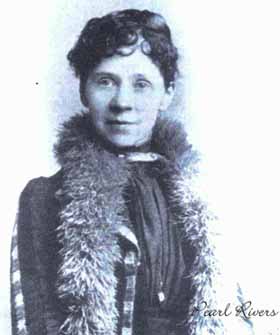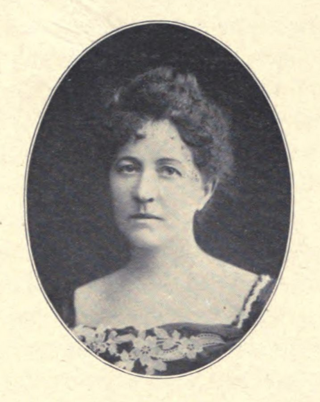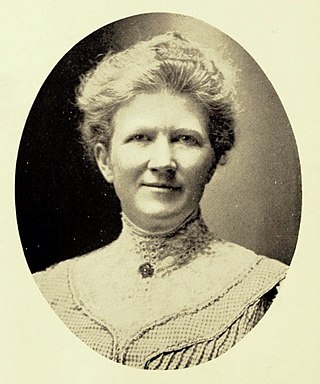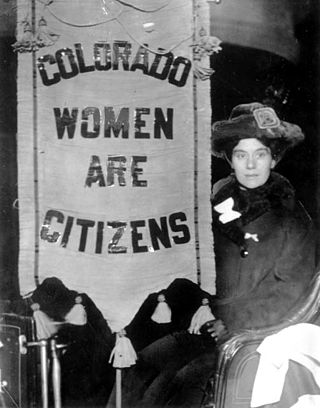
Katherine Wilson Sheppard was the most prominent member of the women's suffrage movement in New Zealand and the country's most famous suffragist. Born in Liverpool, England, she emigrated to New Zealand with her family in 1868. There she became an active member of various religious and social organisations, including the Women's Christian Temperance Union New Zealand. In 1887 she was appointed the WCTU NZ's National Superintendent for Franchise and Legislation, a position she used to advance the cause of women's suffrage in New Zealand.

Queen magazine was a British society publication briefly established by Samuel Beeton in 1861. It became The Queen: The Ladies Newspaper and Court Chronicle before returning to The Queen. In 1958, the magazine was sold to Jocelyn Stevens, who dropped the prefix "The" and used it as his vehicle to represent the younger side of the British Establishment, sometimes referred to as the "Chelsea Set", under the editorial direction of Beatrix Miller. In 1964, the magazine gave birth to Radio Caroline, the first daytime commercial pirate radio station serving London. Stevens sold Queen in 1968. From 1970, the new publication became known as Harper's & Queen after a merger with Harper's Bazaar UK, until the name Queen was dropped altogether from the masthead. It is now known as Harper's Bazaar.

Clara Brown (1800–1885) was a former enslaved woman from Virginia and Kentucky who became a community leader and philanthropist. She helped formerly enslaved people become settled during Colorado's Gold Rush. She was known as the 'Angel of the Rockies' and made her mark as "Colorado's first black settler and a prosperous entrepreneur".

The Omaha Daily Bee, in Nebraska, United States, was a leading Republican newspaper that was active in the late 19th and early 20th century. The paper's editorial slant frequently pitted it against the Omaha Herald, the Omaha Republican and other local papers. After a 1927 merger, it was published as the Bee-News until folding in 1937.

In journalism, the society page of a newspaper is largely or entirely devoted to the social and cultural events and gossip of the location covered. Other features that frequently appear on the society page are a calendar of charity events and pictures of locally, nationally and internationally famous people. Society pages expanded to become women's page sections.

Pearl Rivers was an American journalist and poet, and the first female editor of a major American newspaper. After being the literary editor of the New Orleans Daily Picayune, Rivers became the owner and publisher in 1876, after her elderly husband died. In 1880, she took over as managing editor, where she continued until her death in 1896.

Laura de Force Gordon was a California lawyer, newspaper publisher, and a prominent suffragette. She was the first woman to run a daily newspaper in the United States, and the second female lawyer admitted to practice in California.
Ellen M. Mitchell (1838–1920) was an American philosopher, educator and education reformer. She was one of the first women to be appointed lecturer in a university, in addition to writing philosophy, literature and literary criticism.

Ellis Meredith (1865–1955) was an American suffragist, journalist, and novelist, known as the Susan B. Anthony of Colorado.

Caroline Nichols Churchill was a Canadian-born writer and newspaper editor in the United States, best known as the editor of the Queen Bee, a feminist publication prominent during the Colorado Suffrage movement. As a travel writer and editor, Churchill aimed to promote female independence in the post Civil War West, culminating ultimately in the right to vote in the state of Colorado. Her publications Over the Purple Hills, Over the Evergreen Hills, and Little Sheaves detailed the growth of California as well as her experiences in Texas, Missouri, Kansas, Indian Territory and later Colorado. In 1988, she was inducted into the Colorado Women's Hall of Fame.

Elizabeth Piper Ensley, was an educator and an African-American suffragist. Born in Massachusetts, Ensley was a teacher on the eastern coast of the country. She moved to Colorado where she achieved prominence as a leader in the Colorado suffrage movement. She was also a journalist, activist, and a leader and founder of local women's clubs.

Caroline Bancroft was an American journalist. She is known for the books and booklets that she wrote about Colorado's history and its pioneers. In 1990, she was inducted into the Colorado Women's Hall of Fame.

Theodosia Grace Ammons was an American suffragist, co-founder with Eliza Pickrell Routt of the Department of Domestic Economy at Colorado Agricultural College, and the first female dean at the college.

Therese Alberta Parkinson Jenkins was a suffragist, credited with saving women's suffrage in the State of Wyoming. She was the first woman delegate to any Republican National Convention, the one in Minneapolis in 1892.

Dorothy Louise Vennard Lamm is an American feminist, women's rights activist, educator, author, and speaker. She was First Lady of Colorado during her husband Richard Lamm's three terms as Governor of Colorado (1975–1987), and unsuccessfully ran for the United States Senate as the Colorado Democratic candidate in 1998. She wrote a weekly column for The Denver Post from 1979 to 1996 and later published three books. She was inducted into the Colorado Women's Hall of Fame in 1985.
The Portland Bee was a Republican newspaper in Portland in the U.S. state of Oregon in the late 19th century. It was launched in November 1875, the same year as the Portland Daily Bulletin disincorporated; like the Bulletin, it had both daily and weekly editions. It initially had two daily editions, and circulated 1,000 free copies.

In 1893, Colorado became the second state in the United States to grant women's suffrage and the first to do so through a voter referendum. Even while Colorado was a territory, lawmakers and other leaders tried to include women's suffrage in laws and later in the state constitution. The constitution did give women the right to vote in school board elections. The first voter referendum campaign was held in 1877. The Woman Suffrage Association of Colorado worked to encourage people to vote yes. Nationally-known suffragists, such as Susan B. Anthony and Lucy Stone spoke alongside Colorado's own Alida Avery around the state. Despite the efforts to influence voters, the referendum failed. Suffragists continued to grow support for women's right to vote. They exercised their right to vote in school board elections and ran for office. In 1893, another campaign for women's suffrage took place. Both Black and white suffragists worked to influence voters, gave speeches, and turned out on election day in a last-minute push. The effort was successful and women earned equal suffrage. In 1894, Colorado again made history by electing three women to the Colorado house of representatives. After gaining the right to vote, Colorado women continued to fight for suffrage in other states. Some women became members of the Congressional Union (CU) and pushed for a federal suffrage amendment. Colorado women also used their right to vote to pass reforms in the state and to support women candidates.

This is a timeline of women's suffrage in Colorado. Women's suffrage efforts started in the late 1860s. During the state constitutional convention for Colorado, women received a small win when they were granted the right to vote in school board elections. In 1877, the first women's suffrage referendum was defeated. In 1893, another referendum was successful. After winning the right to vote, Colorado women continued to fight for a federal women's suffrage amendment. While most women were able to vote, it wasn't until 1970 that Native Americans living on reservations were enfranchised.

Minnie Reynolds Scalabrino was an American journalist, women's rights activist, and organizer, founding the Denver Women's Press Club and Denver Woman's Club. She advocated for equal rights, women's suffrage and temperance, something that she was devoted to for more than 30 years. She was instrumental in the passage of laws that gave women the right to vote at the state level, and then in 1920 for women throughout the United States.


















